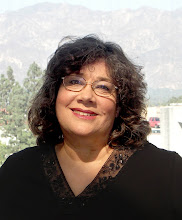
Nobody got it right on the money but Ben came closest with his answer "first bridge over the Arroyo Seco." He wins a fabulous prize! (Ben, I don't have an email address for you, so please email me at aerdman@cityofpasadena.net and I'll let you know what you've won.)
From the late 1880s to 1913 the Scoville Bridge served as the first and only reliable link between the west and east sides of the Arroyo Seco. It stood within a few yards from where the Colorado Street Bridge is today.
The bridge connected Arroyo Drive (now Arroyo Boulevard) on the east side to a country road that ran along what is now Colorado Boulevard on the west side.
The opening of the bridge represented a whole new world to people who wanted to get from Pasadena to Glendale and vice versa.
The privately owned trestle bridge was part of the Scoville Dam, Bridge and Water Works (you can see the bridge at center left below, peeking out from the trees).

James W. Scoville was a real estate developer, businessman and philanthropist in Oak Park, Ill. (near Chicago), who came to Pasadena along with many other captains of industry in the late 1800s. In suburban Chicago he had been vice president of the Elgin Watch Company and president of the Prairie State Bank. After moving to Pasadena, he was an early trustee of Throop University, which would later become Caltech.

Before the existence of the Scoville Bridge, the only way to get from one side of the arroyo to the other was by riding a horse or walking along trails down the steep embankments, crossing the stream and climbing up the other side. The area was prone to landslides and floods, so it was often a precarious proposition.

The Arroyo Seco was not public land at the time. A land boom in Pasadena in 1886 -- the year the city was incorporated -- was followed by a depression during which James W. Scoville and his son, Charles Burton Scoville, hired workers to construct the dam, bridge and pump house. This project kept otherwise unemployed workers busy for some time.
The pump house sent water from the pond behind the dam up the banks of the Arroyo Seco to irrigate the Scoville family's orange and avocado groves.
The bridge was washed away by storm waters in 1914. The good news was that the mighty Colorado Street Bridge had opened for traffic in 1913.
For the sake of perspective, here's the mighty Colorado Street Bridge under construction near the Scoville Bridge.

The Scoville bridge, dam and pump house are included in an application submitted two years ago by Pasadena Heritage in hopes of having the Pasadena Arroyo Parks and Recreation District included on the National Register of Historic Places. It became official in November 2008.
Remnants of the Scoville project can be seen to this day under the Colorado Street Bridge.
Many thanks to Pasadena Public Library and Pasadena Museum of History for use of the photos.

9 comments:
All right Ben! Love these pictures and stories Ann.
This is really interesting. I love the photo with both bridges.
Much of this is news to me. I'm trying to match images to what I know of the area today. The grove and that street that I'm guessing is Linda Vista. Also is the base of the dam still in existence. What remnants?
I have Ben's email, PIO! I told him his award is to be Mayor For A Day!
Congratulations, Ben!
Where can we see those remnants, Ann? I know of an old bridge and dam there, but nothing as old as this.
Oh man, Skunked again. Fun lesson though. Thanks, Ann.
Ann, this is great stuff! Particularly enjoyed that last photo showing the partially built Colorado St. Bridge.
PA, a good part of that hillside was plowed through years later to make way for the 134 freeway.
There's not much left in the way of remnants but there are little parts of pilings and a few stair steps. You really have to go down and hunt around. They're kind of hiding in plain sight.
Love the history!
Ben, congrats!!!!
Post a Comment